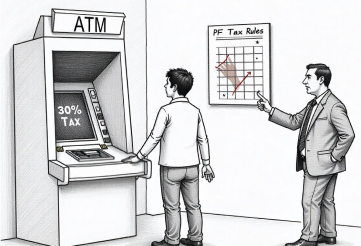Think before you Withdraw – Tax that can cost you 30% of your PF
We work hard and save money tirelessly for a comfortable and safe retired future, but what we all tend to overlook is the tax that tags along with your PF when you withdraw it.
According to the report on UNFPA – India, in accordance with the rising life expectancy and aging populations, the percentage of elderly people is predicted to be double over around 20% of the population in the next 25 years.
This means that a larger part of India’s population will soon rely on their retirement savings, yet a huge part of them remains clueless about the tax rules that can eat away 30% of their PF. If you don’t feel intimidated by this because of the EEE Tax status, then you might have to reconsider.
The EEE tax status is only applicable when certain conditions are met – if they are not met, you may lose up to 30% of your PF to Tax.
How to Withdraw Tax – Free?
Want to Withdraw your PF tax-free? - Then your first step is to have completed five or more years of service continuously.
But when you try to withdraw your PF without the completion of the continuous five years of service, you will be imposed loads of hidden taxes.
The Tax Trap – Tax hidden in plain sight
Withdrawals for Marriage and Children Education are non-taxable if they have a service of 7 years meanwhile for house purposes and early retirement it is non-taxable if they have 5 years of service and service transfer is also tax-free.
However, withdrawals before 5 years of service in case of illness or retirement are considered for tax.

Let’s break down tax that may be applied to you if your service period is less than 5 years:
| Employee’s Contribution | Considered taxable if claimed under section 80C |
| Employer’s Contribution | Fully taxable as it is considered as “salary” |
| Interest from Employee’s Contribution | Fully taxable as it is considered as “income from other sources” |
| TDS at withdrawal Contribution | 10% TDS applied if withdrawal is more than 50,000 |
Insights on Withdrawals:
| EPF Full Withdrawals |
|
| EPF Partial Withdrawals | Can be withdrawn for specific cases like:
|
| NPS Full Withdrawals |
|
| NPS Partial Withdrawals |
|
| Online Withdrawals |
|
| Offline Withdrawals |
|
Conclusion:
According to various reports, as of March 2023, out of ~29.9 crore EPF accounts, the accounts that were active only amounted to around 6.85 crore, indicating the rising dormant accounts.
Most of the people who don’t use their EPF accounts is because they lack knowledge about its profit in the long run and those who know the benefits and try to make use of it, aren’t aware of these TAX Traps.
To get the most out of your money, it’s always best to contact a professional. Tax360 we have professionals who can help you manage your taxes, work on transforming your dormant EPF account, and provide expert guidance.